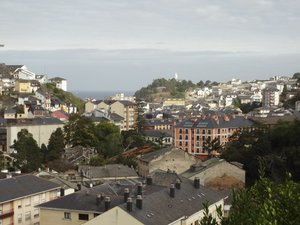Advertisement
Published: October 18th 2014

 Luarca, on the Asturias Coast
Luarca, on the Asturias Coast
You can see the clouds lurking off the coast, but they never rained on us that day.We decided not to drive the whole trip around northern Spain, since there’s a narrow gauge railway that travels most of the way from the north-west corner to the French border. It’s called FEVE (pronounced fay-vay) and is a regional, sometimes commuter line, with some freight trains, some cars set up for commuters (hard seats) and some for longer distances. It doesn’t run like the rest of Renfe, but is older-fashioned, with poorer maintenance for its facilities and a more casual attitude toward schedules. HAH! One Sunday afternoon, the train was so late that when we were about 15 km from our planned city, they took all of us (maybe 20 people) off the train, put us in taxis to our various stops, and sent the train back west to get ready for the Monday morning rush hours. Amazing – just gave up.
The province of Asturias is wild and beautiful and the good weather continued. Every morning, we were sure it would rain all day, and every day, the sky turned blue. We got on the train in Ferrol, planning to travel to San Sebastian, and traveled from town to town on the railway, stopping overnight to walk around

 3 Cabos Hotel Rural
3 Cabos Hotel Rural
On our only rainy day, we sat in the lounge area of this inn and watched the rain, fog and sea.the beautiful small towns, including Luarca, Aviles, Oviedo, and Llanes. I think that if we ever win the lottery (slim chance, because we never buy tickets), Tom will want to buy a house in Llanes.
As we traveled along the northern coast, our usual routine was to have a small breakfast at our hotel or somewhere in town, usually excellent fresh-squeezed orange juice, excellent coffee and some sort of excellent bread. Dinner/supper was a pinxto hunt. OK, did I explain them already? Farther south in Spain, they’re called tapas, here they are pinchos or pinxtos. They are small, savory treats, usually served on a very small dish, never larger than a saucer. They can contain meat, fish, shellfish, cheese, bread, or vegetables – anything the host thinks will tempt customers. Sometimes, a tapas restaurant will become famous for serving just one really good thing, like a place that just served three grilled mushrooms stacked on a round of bread and topped with garlic butter and a shrimp. Drinks are anything you want, but usually wine, beer or “sidre”, hard, not sweet cider. They pour the cider from as long a distance as their arms will reach to break the

 A Picture for Glen
A Picture for Glen
We took this picture for Glen because we knew he would know where the lamp was originally used.bubbles – it’s fun to watch, but don’t get too close, since you may get splashed.
Information on the rail and bus connections is not easy to find and FEVE’s reliability and timeliness weren’t stellar, so we gave up on the idea of getting to San Sebastian on the train because that required very short (15 minute) connections in either Santander or Bilbao. We ended up waiting hours for a bus ride from Santander to San Sebastian, but were rewarded with no stress.
Advertisement
Tot: 0.109s; Tpl: 0.011s; cc: 11; qc: 48; dbt: 0.0515s; 1; m:domysql w:travelblog (10.17.0.13); sld: 1;
; mem: 1.2mb

 Luarca, on the Asturias Coast
Luarca, on the Asturias Coast
 3 Cabos Hotel Rural
3 Cabos Hotel Rural
 A Picture for Glen
A Picture for Glen






